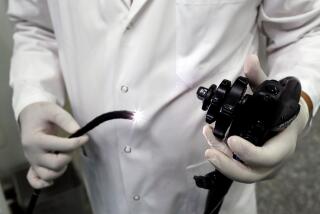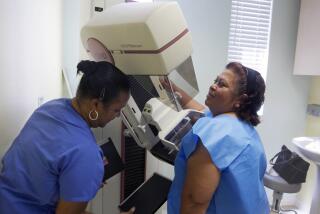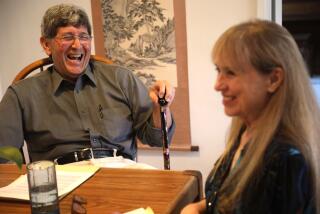Screening mammograms save fewer lives than you think
If you or someone you know discovered she had breast cancer thanks to routine mammography screening, and if you or that friend with breast cancer got treatment and today is cancer-free, it’s natural to assume that the mammogram was a life-saver.
But odds are, it wasn’t.
More likely, the cancer that was picked up by that mammogram would have been just as treatable even if it hadn’t been caught until you or your friend felt a lump in the breast. It’s also entirely possible that the cancer wouldn’t have killed you (or your friend) if it had been left alone, untreated.
More than 75% of women who found out they had breast cancer from a screening mammogram fell into one of these two categories, and no more than 25% of them can give the test credit for saving their lives.
So says a study published online Monday by Archives of Internal Medicine. The authors – Dr. H. Gilbert Welch and Brittney A. Frankel of the Dartmouth Institute for Health Policy and Clinical Practice – used data from the National Cancer Institute to arrive at this conclusion.
Their calculation depends on two things. First, what is the probability that a mammogram will pick up a breast cancer in a woman with no symptoms of the disease? Second, what is the probability that the early diagnosis will allow that woman to beat a cancer that otherwise would have been deadly?
The answers to both of those questions depend on a woman’s age, so the researchers ran the numbers for women at ages 40, 50, 60 and 70. The answer to the second question also depends on the degree to which screening mammograms reduce the risk of death from breast cancer, so the researchers used several different estimates ranging from 5% relative risk reduction to 25%.
Let’s consider the case of a 50-year-old woman in good health with no family history of breast cancer:
Based on data from the National Cancer Institute, we know that the probability that she will develop breast cancer over the next 10 years is just under 3% (2,990 cases per 100,000 women). Among women of her age, 64% of those breast cancers are caught by screening mammograms, so the probability that she will find out she has breast cancer thanks to a mammogram is just under 2% (1,910 per 100,000 women).
The probability that a 50-year-old woman will die of breast cancer over the next 20 years are slightly less than 1% (990 deaths per 100,000 women). But that figure is based on actual women (some of whom had their lives saved or extended by screening mammograms) and would be higher if mammograms didn’t exist. If you assume that screening reduces the risk of death by 20%, then the probability that a 50-year-old woman would die of breast cancer over the next 20 years if she didn’t have any mammograms rises to 1.24% (1,240 deaths per 100,000 women). Simple subtraction suggests that screening saves 250 lives per 100,000 women.
The researchers compared those 250 lives saved with the 1,910 women who discovered their breast cancers via screening mammograms and calculated that the probability that our hypothetical 50-year-old owes her life to a mammogram are only 13% (250 divided by 1,910).
That rises to 17% if you give screening mammograms credit for reducing the risk of breast cancer death by 25% instead of 20%. On the other hand, if you assume that screening mammograms only reduce the risk of breast cancer mortality by 5%, then the probability that a 50-year-old woman with breast cancer had her life saved by the test falls to 3%.
The numbers also change depending on a woman’s age. In the analysis, screening mammograms were most likely to save the lives of women who were 70. But even in that age group, fewer than 25% of women whose cancers were caught by the test could honestly say that it saved their lives, the researchers found.
Based on the most recent data from large European studies, the benefit of screening mammography is probably so low that the probability that the test will save a woman’s life is “likely to be well below 10%,” the Welch and Frankel write.
Yet any suggestion that women get fewer mammograms is met with sharp resistance from oncologists, radiologists and especially from breast cancer survivors. The sheer numbers of breast cancer survivors has risen dramatically in the last 40 years, with an estimated 2.5 million of them alive today. Ironically, that success has helped reduce the rate at which screening mammograms save lives – as more women are screened, the number of true success stories is diluted by cases of women whose cancers would have been treatable without screening or whose cancers would never have harmed them.
“This self-reinforcing cycle … is driven, in part, by the presumption that every screen-detected breast cancer survivor has had her ‘life saved’ because of screening,” the researchers write. “Our analyses suggest this is an exaggeration. In fact, a woman with screen-detected breast cancer is considerably more likely not to have benefited from screening. We believe that this information is important to put cancer survivor stories in their proper context.”
The entire study is online here.
In a commentary that accompanies the study (but is behind a pay wall), two researchers from the Minneapolis VA Center for Chronic Disease Outcomes Research and the University of Minnesota endorse the counterintuitive findings. They acknowledge that when cancers are discovered at an advanced stage, cure is a long shot. But that doesn’t necessarily mean that finding a cancer at the earliest stage is always better.
“Patients and their clinicians assume that outcomes would be worse if the condition were left undiagnosed and untreated, and survival is then attributed to these interventions,” write Dr. Timothy J. Wilt and Melissa R. Partin. “However, longer survival times are poor predictors of the effectiveness of treatment and more accurately reflect changing diagnostic methods.”







